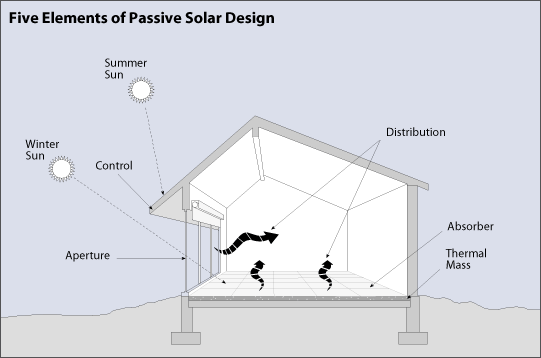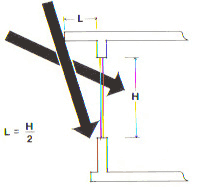what are some ways to utilize passive solar design
Passive solar design refers to the use of the lord's day'south energy for the heating and cooling of living spaces by exposure to the sun. When sunlight strikes a building, the edifice materials can reverberate, transmit, or absorb the solar radiation. In improver, the oestrus produced by the sun causes air movement that can be predictable in designed spaces. These basic responses to solar heat lead to design elements, cloth choices and placements that tin can provide heating and cooling effects in a home.
Unlike active solar heating systems, passive systems are unproblematic and do not involve substantial employ of mechanical and electrical devices, such as pumps, fans, or electrical controls to motility the solar energy.
Passive Solar Pattern Basics
A consummate passive solar design has v elements:

- Aperture/Collector: The large glass area through which sunlight enters the building. The aperture(s) should face within xxx degrees of true due south and should non be shaded by other buildings or trees from 9a.m. to 3p.m. daily during the heating flavor.
- Absorber:The hard, darkened surface of the storage element. The surface, which could be a masonry wall, floor, or water container, sits in the direct path of sunlight. Sunlight hit the surface is absorbed equally heat.
- Thermal mass: Materials that retain or store the heat produced by sunlight. While the cushion is an exposed surface, the thermal mass is the material below and backside this surface.
- Distribution: Method past which solar heat circulates from the collection and storage points to different areas of the house. A strictly passive design will utilise the three natural heat transfer modes- conduction, convection and radiation- exclusively. In some applications, fans, ducts and blowers may be used to distribute the heat through the house.
- Control: Roof overhangs can be used to shade the aperture surface area during summer months. Other elements that control under and/or overheating include electronic sensing devices, such as a differential thermostat that signals a fan to turn on; operable vents and dampers that allow or restrict heat menses; low-emissivity blinds; and awnings.
Passive Solar Heating
The goal of passive solar heating systems is to capture the sun's rut within the edifice'due south elements and to release that estrus during periods when the sun is absent-minded, while also maintaining a comfortable room temperature. The 2 main elements of passive solar heating are due south facing glass and thermal mass to absorb, store, and distribute heat. At that place are several unlike approaches to implementing those elements.
Directly Gain
The actual living space is a solar collector, oestrus absorber and distribution system. South facing glass admits solar energy into the house where it strikes masonry floors and walls, which absorb and store the solar heat, which is radiated back out into the room at nighttime. These thermal mass materials are typically nighttime in color in club to absorb every bit much rut as possible. The thermal mass too tempers the intensity of the heat during the day by absorbing energy. Water containers inside the living space can exist used to store heat. However, unlike masonry water requires advisedly designed structural support, and thus it is more difficult to integrate into the design of the business firm. The direct proceeds system utilizes threescore-75% of the sunday'due south energy hitting the windows. For a direct gain system to work well, thermal mass must be insulated from the outside temperature to prevent collected solar estrus from dissipating. Heat loss is especially likely when the thermal mass is in direct contact with the basis or with exterior air that is at a lower temperature than the desired temperature of the mass.
Indirect Gain
Thermal mass is located between the sun and the living infinite. The thermal mass absorbs the sunlight that strikes information technology and transfers it to the living space by conduction. The indirect gain system will utilize 30-45% of the dominicus'south energy striking the glass adjoining the thermal mass.

The well-nigh mutual indirect gain systems is a Trombe wall. The thermal mass, a 6-18 inch thick masonry wall, is located immediately behind south facing glass of single or double layer, which is mounted most i inch or less in forepart of the wall'due south surface. Solar heat is absorbed past the wall's dark-colored outside surface and stored in the wall's mass, where it radiates into the living space. Solar heat migrates through the wall, reaching its rear surface in the late afternoon or early evening. When the indoor temperature falls below that of the wall's surface, heat is radiated into the room.
Operable vents at the top and bottom of a thermal storage wall let oestrus to convect between the wall and the glass into the living space. When the vents are closed at night, radiant heat from the wall heats the living space.
Passive Solar Cooling
Passive solar cooling systems work by reducing unwanted oestrus gain during the twenty-four hours, producing not-mechanical ventilation, exchanging warm interior air for libation exterior air when possible, and storing the coolness of the night to moderate warm daytime temperatures. At their simpliest, passive solar cooling systems include overhangs or shades on due south facing windows, shade trees, thermal mass and cross ventilation.
Shading

To reduce unwanted oestrus gain in the summer, all windows should be shaded by an overhang or other devices such equally awnings, shutters and trellises. If an awning on a south facing window protrudes to half of a window's height, the sun's rays volition be blocked during the summer, notwithstanding will withal penetrate into the house during the winter. The lord's day is low on the horizon during sunrise and dusk, so overhangs on east and west facing windows are not every bit constructive. Try to minimize the number of east and west facing windows if cooling is a major business concern. Vegetation tin can be used to shade such windows. Landscaping in general can be used to reduce unwanted rut gain during the summer.
Thermal Mass
Thermal mass is used in a passive cooling design to absorbs heat and moderate internal temperature increases on hot days. During the night, thermal mass can be cooled using ventilation, assuasive it to exist set the next 24-hour interval to absorb oestrus again. It is possible to use the aforementioned thermal mass for cooling during the hot flavour and heating during the cold season.
Ventilation
Natural ventilation maintains an indoor temperature that is close to the outdoor temperature, so it's only an constructive cooling technique when the indoor temperature is equal to or higher than the outdoor 1. The climate determines the best natural ventilation strategy.
In areas where there are daytime breezes and a want for ventilation during the twenty-four hours, open windows on the side of the building facing the breeze and the opposite 1 to create cross ventilation. When designing, place windows in the walls facing the prevailing breeze and opposite walls. Wing walls tin can also be used to create ventilation through windows in walls perpendicular to prevailing breezes. A solid vertical console is placed perpendicular to the wall, betwixt two windows. It accelarates natural current of air speed due to pressure level differences created past the wing wall.
In a climate like New England where nighttime time temperatures are generally lower than daytime ones, focus on bringing in cool night air and so closing the house to hot outside air during the solar day. Mechanical ventilation is one way of bringing in absurd air at night, but convective cooling is another option.
Convective Cooling
The oldest and simplest class of convective cooling is designed to bring in absurd nighttime air from the outside and push out hot interior air. If there are prevailing nightime breezes, and so high vent or open on the leeward side (the side away from the wind) will allow the hot air near the ceiling escape. Depression vents on the opposite side (the side towards the wind) volition let absurd night air sweep in to replace the hot air.
At sites where at that place aren't prevailing breezes, information technology's still possible to employ convective cooling past creating thermal chimneys. Thermal chimneys are designed around the fact that warm air rises; they create a warm or hot zone of air (oftentimes through solar gain) and take a high exterior exhaust outlet. The hot air exits the building at the loftier vent, and cooler air is drawn in through a depression vent.
There are many different approaches to creating the thermal chimney outcome. One is an attached south facing sunroom that is vented at the top. Air is drawn from the living infinite through connecting lower vents to be exhausted through the sunroom upper vents (the upper vents from the sunroom to the living space and any operable windows must be closed and the thermal mass wall of the sunroom must be shaded).
Source: https://sustainability.williams.edu/green-building-basics/passive-solar-design/
0 Response to "what are some ways to utilize passive solar design"
Post a Comment